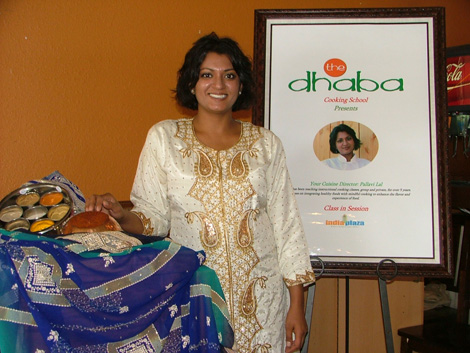If the sounds, and tastes, of masalas, rotis, chutneys, tandoor and other items of Punjabi cuisine inspire you, stop by or call the new Dhaba Cooking School in Tempe. Punjab is one of the northern provinces of India and, in turn, Punjabi is the culinary style at the award-winning restaurant.

The centerpiece of Raveen and Clara Arora’s India Plaza center, 1874 E. Apache Blvd., just east of McClintock Drive, The Dhaba restaurant is offering its second series of five-week Indian cooking classes beginning Thursday evening, Aug. 11, 6–8 p.m. These are the only such Indian cooking classes held in the Valley, Raveen notes.
Led by accomplished Indian chef, Pallavi Lal, the first course attracted novice and experienced chefs hoping to learn more about North Indian spices, cookware, preparation as well as the culture of India. This first session was June 16–July 14.
Limited to 16, the classes take place in The Dhaba Café, adjacent to The Dhaba restaurant. For breakfast and lunch, the Dhaba Café offers drinks and chaats, or small Indian treats. Dhaba is open for lunch and dinner seven days a week.
“For years, Dhaba has meant the finest North Indian cuisine in the Valley, and now The Dhaba Cooking School classes continue this tradition,” says Raveen, who opened India Plaza in 2003. “Despite the economic downturn, The Dhaba has delivered consistent high quality to residents of and visitors to the Valley.”
The Dhaba has won numerous culinary awards from local magazines and Web sites including New Times. The name derives from truckstop eateries found throughout India.
The 10,000-square-foot India Plaza — “Where India Comes Alive!”— is just across from a METRO light rail station, which India Plaza helps maintain as part of its investment in the Tempe community. The two-acre campus is a one-stop destination for Indian food and culture and includes a market, gift shop, restaurant, cafe and beauty salon.
Together, students learn traditional dishes as well as the basics of the Indian kitchen, including cookware such as the kadahi; basic pantry items such as ghee (butter) and lentils; the C-5 spices — cinnamon, cloves, chilis, coriander and cumin — and others comprising the Indian spice box: Garam Masala (the C-5s combined), lal mirchi (chili powder), turmeric, ginger and garlic.
Chef Lal also teaches the healing properties of the spices and pantry items as part of her holistic approach to quality food and physical and mental health. “Indian spices just don’t add to the taste of the food; they offer generous health benefits as well,” she explains.
Cumin, she says, improves memory; coriander helps lower cholesterol levels and heal mouth ulcers and skin disorders; cinnamon assists brain activity and blood circulation; and cardamom is an anti-spasmodic, an aphrodisiac and diuretic; and cloves help with toothaches, indigestion, cough, asthma, headache and stress.
In addition, turmeric assists in thwarting development of anti-inflammatory diseases; lal mirchi aids in weight loss, good digestion, strong immunity and blood circulation; ginger can relieve pains related to menstrual disorders; and garlic helps to fight heart ailments and lowers blood pressure levels.
Finally, ghee conduces to healthy skin, mental clarity and good digestion and lentils are high in Vitamins C and the B and contain eight of the essential amino acids.
“The recipes shared in class are ones that passed down from many generations and have been integrated into The Dhaba menu,” says Chef Lal, a Gilbert resident who first met the Aroras about five years ago when she visited India Plaza for groceries.
“The taste of the food is fresh, pure and authentic; with the instruction and experience from the classes, anyone can learn how to prepare this outstanding food,” she adds.
